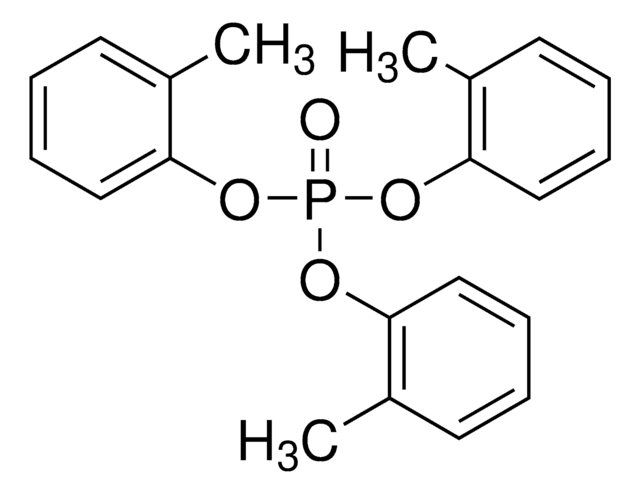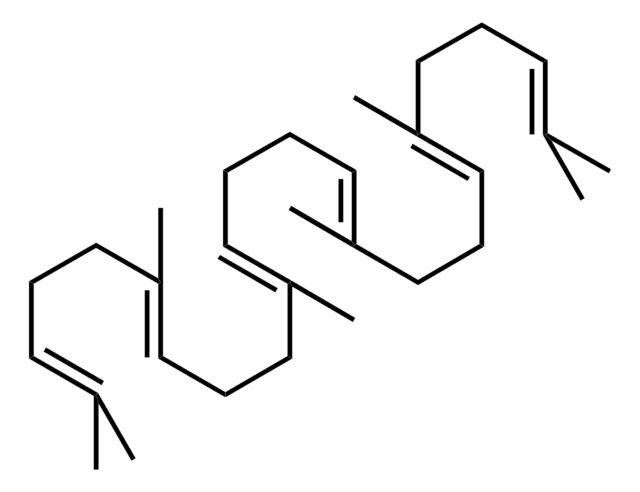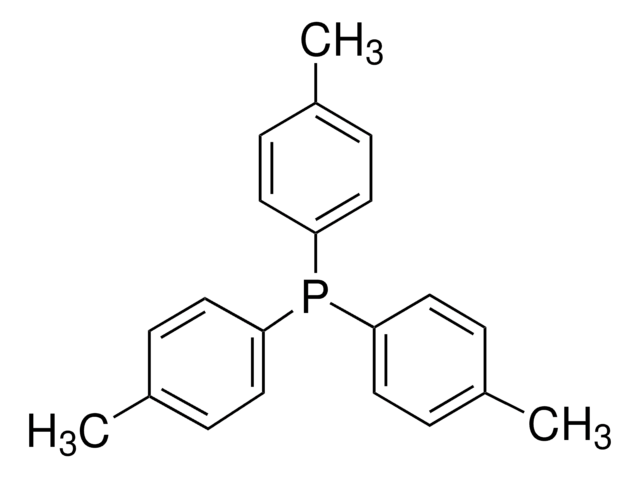All Photos(1)
About This Item
Empirical Formula (Hill Notation):
C21H21O4P
CAS Number:
Molecular Weight:
368.36
EC Number:
MDL number:
UNSPSC Code:
12352200
PubChem Substance ID:
Recommended Products
form
solid
SMILES string
Cc1cccc(OP(=O)(Oc2cccc(C)c2)Oc3cccc(C)c3)c1
InChI
1S/C21H21O4P/c1-16-7-4-10-19(13-16)23-26(22,24-20-11-5-8-17(2)14-20)25-21-12-6-9-18(3)15-21/h4-15H,1-3H3
InChI key
RMLPZKRPSQVRAB-UHFFFAOYSA-N
Other Notes
Please note that Sigma-Aldrich provides this product to early discovery researchers as part of a collection of unique chemicals. Sigma-Aldrich does not collect analytical data for this product. Buyer assumes responsibility to confirm product identity and/or purity. All sales are final.
NOTWITHSTANDING ANY CONTRARY PROVISION CONTAINED IN SIGMA-ALDRICH′S STANDARD TERMS AND CONDITIONS OF SALE OR AN AGREEMENT BETWEEN SIGMA-ALDRICH AND BUYER, SIGMA-ALDRICH SELLS THIS PRODUCT "AS-IS" AND MAKES NO REPRESENTATION OR WARRANTY WHATSOEVER WITH RESPECT TO THIS PRODUCT, INCLUDING ANY (A) WARRANTY OF MERCHANTABILITY; (B) WARRANTY OF FITNESS FOR A PARTICULAR PURPOSE; OR (C) WARRANTY AGAINST INFRINGEMENT OF INTELLECTUAL PROPERTY RIGHTS OF A THIRD PARTY; WHETHER ARISING BY LAW, COURSE OF DEALING, COURSE OF PERFORMANCE, USAGE OF TRADE OR OTHERWISE.
NOTWITHSTANDING ANY CONTRARY PROVISION CONTAINED IN SIGMA-ALDRICH′S STANDARD TERMS AND CONDITIONS OF SALE OR AN AGREEMENT BETWEEN SIGMA-ALDRICH AND BUYER, SIGMA-ALDRICH SELLS THIS PRODUCT "AS-IS" AND MAKES NO REPRESENTATION OR WARRANTY WHATSOEVER WITH RESPECT TO THIS PRODUCT, INCLUDING ANY (A) WARRANTY OF MERCHANTABILITY; (B) WARRANTY OF FITNESS FOR A PARTICULAR PURPOSE; OR (C) WARRANTY AGAINST INFRINGEMENT OF INTELLECTUAL PROPERTY RIGHTS OF A THIRD PARTY; WHETHER ARISING BY LAW, COURSE OF DEALING, COURSE OF PERFORMANCE, USAGE OF TRADE OR OTHERWISE.
Signal Word
Warning
Hazard Statements
Precautionary Statements
Hazard Classifications
Acute Tox. 4 Dermal - Acute Tox. 4 Oral - Aquatic Chronic 2
Storage Class Code
11 - Combustible Solids
WGK
WGK 3
Flash Point(F)
Not applicable
Flash Point(C)
Not applicable
Certificates of Analysis (COA)
Search for Certificates of Analysis (COA) by entering the products Lot/Batch Number. Lot and Batch Numbers can be found on a product’s label following the words ‘Lot’ or ‘Batch’.
Already Own This Product?
Find documentation for the products that you have recently purchased in the Document Library.
Xiang Ge et al.
Environment international, 139, 105741-105741 (2020-04-20)
Electronic waste (e-waste) dismantling is an important source of flame retardant emissions, and may have potentially adverse effects on surrounding area. This study investigated their influence on the surrounding area and the human health risks after an industrial park was
Daniel J Duarte et al.
Neurotoxicology, 59, 222-230 (2016-02-07)
Exposure to tricresyl phosphates (TCPs), via for example contaminated cabin air, has been associated with health effects including the so-called aerotoxic syndrome. While TCP neurotoxicity is mainly attributed to ortho-isomers like tri-ortho-cresyl phosphate (ToCP), recent exposure and risk assessments indicate
Long Pang et al.
Environmental science and pollution research international, 26(27), 27862-27871 (2019-07-26)
In this study, nine OPEs were measured in 60 street dust samples collected from the central province of Henan, China. The total concentrations of OPEs (∑9OPEs) in street dust range from 2.77 to 505 μg/kg (median 59.3 μg/kg). Chlorinated OPEs are dominant
Xiaoqing Wang et al.
Chemosphere, 226, 159-165 (2019-03-31)
Organophosphate flame retardants (OPFRs) have been reported to induce cytotoxicity in a structure-dependent manner. The toxic effects may be due to the damage of biomembrane integrity and/or the interference of membrane signal pathway. In this study, the damages of fifteen
Wenhui Li et al.
Environmental pollution (Barking, Essex : 1987), 241, 566-575 (2018-06-10)
As a major group of plasticizers and flame-retardants, organophosphate esters (OPEs) have attracted particular attention due to their wide occurrence and potential impacts on human health and ecosystems. In the present study, the occurrence and distribution of 14 OPEs, including
Our team of scientists has experience in all areas of research including Life Science, Material Science, Chemical Synthesis, Chromatography, Analytical and many others.
Contact Technical Service










